During The Netherlands Film Festival, we joined with our little The Netherlands Film Star Postcard Festival. The final post of our Netherlands Film Star Postcard Festival is about actor Adolphe Engers (1884-1945), who appeared in some 55 German and Dutch films during the 1920s and 1930s.
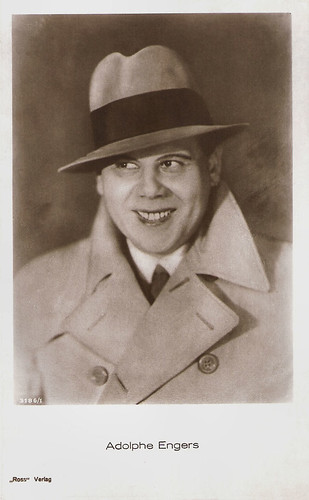
German postcard by Ross Verlag, no. 3186/1, 1928-1929.
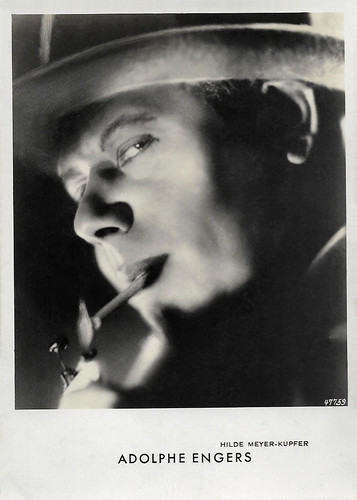
Dutch postcard, no. 47759. Photo: Hilde Meyer-Kupfer.
Adolphe 'Dolph' Engers was born in 1884 in Gulpen, in the south of the Netherlands. He was the son of Jewish policeman Wicher Engers en his wife Jetje Wolf. He had three brothers and a sister. Engers attended a trade school in Elberfeld, Germany. There he also took acting classes from Max Martersteig. He returned to the Netherlands and worked for a while for an insurance company.
While he was in Nice for his work, he got in contact with actors of the Comédie-Française and started to work as an extra for the famous French stage company. In Paris, he made also his first film appearances for Gaumont. An actor's strike in France forced him to return to the Netherlands.
In 1912 he was back in Holland and got employment as a stage actor. He also worked as a translator, in particular of 'The Devil' and other works of Hungarian author Ferenc (or Franz) Molnar, but also works by Oscar Wilde, W. Somerset Maugham and Luigi Pirandello.
Engers made his Dutch film debut with De Kroon der schande/The Crown of Shame (Maurits Binger, 1918). Soon followed roles in the British-Dutch production Fate's Plaything/Wat eeuwig blijft (Maurits Binger, B.E. Doxat-Pratt, 1920) and the Dutch production De Bruut/The Brute (Theo Frenkel, 1922).
Engers was married for one week to one of Louis Bouwmeester's daughters before he ended the marriage. He was gay. In 1917, he wrote a stage play on Oscar Wilde, which was never performed, and in 1920 he published 'Peccavi...???', a then-scandalous novel with a gay protagonist, co-written with fellow actor Ernst Winar.
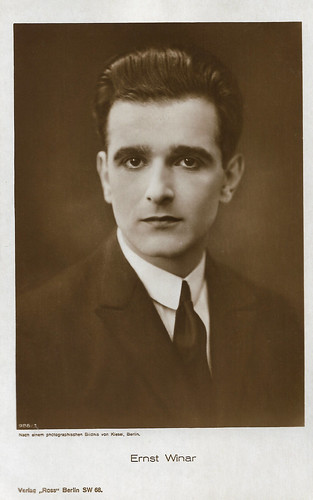
Ernst Winar. German postcard, no. 988/1, 1925-1926. Photo: Kiesel, Berlin. The Dutch actor-director Ernst Winar directed Adolphe Engers in the silent Flappy serial in Berlin, and later again in Holland in Op stap/On the Road (1935).
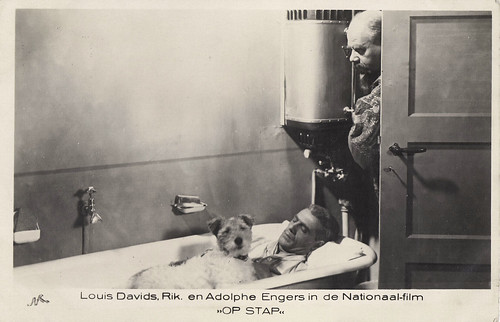
Dutch postcard by M.B. & Z. (M. Bonnist & Zonen, Amsterdam). Photo: Dick van Maarseveen, Den Haag / Nationaal Film. Publicity still for Op stap/On the Road (Ernst Winar, 1935) with Louis Davids, Rik the dog and Adolphe Engers.
In 1920, Adolphe Engers moved to Germany where he became a very busy film actor. He played in well-known films like Die Benefiz-Vorstellung der vier Teufel/The Benefit performance of the Four Devils (A.W. Sandberg, 1920), Die Geliebte Roswolskys/Roswolsky's Mistress (Felix Basch, 1921) starring the Danish diva Asta Nielsen, and Sie und die Drei/She and the Three (Ewald André Dupont, 1922) starring Henny Porten.
He worked together with Dutch director Jaap Speyer on Der Frauenkönig/The King of the Ladies (Jaap Speyer, 1923), and appeared as Don Esteban Paqueno in Friedrich Wilhelm Murnau’s delicious comedy Die Finanzen des Grossherzogs/Finances of the Grand Duke (1924). He then appeared in Auf Befehl der Pompadour/By Order of That Pompadour Woman (Friedrich Zelnik, 1924) and Elegantes Pack/The Elegant Bunch (Jaap Speyer, 1925) with Eugen Klöpfer, Mary Odette and Ralph Arthur Roberts.
He was also very successful with the Flappy serial, three comedies directed by Ernst Winar for the Berliner Terra Film AG. Winar directed him also in the Dutch-German crime film De man op den Achtergrond/Der Mann im Hintergrund/The Man in the Background (Ernst Winar, 1923). In the second part of the 1920s, the impressive actor went on to appear in such films as Der Prinz und die Tänzerin/The Prince and the Dancer (Richard Eichberg, 1926) with Hans Albers, Die Fahrt ins Abenteuer/The Wooing of Eve (Max Mack, 1926) with Ossi Oswalda and Willy Fritsch.
He appeared again opposite Asta Nielsen in Gehetzte Frauen/Badgered Women (Richard Oswald, 1927). With Liane Haid, he played in Die Königin seines Herzens/The Queen of His Heart (Victor Janson, 1928).
Till the end of the silent era followed Don Juan in der Mädchenschule/Don Juan in the Girls’ School (Reinhold Schünzel, 1928), Sündig und süss/Sinful and Sweet (Carl Lamac, 1929) with Anny Ondra, and Sensation im Wintergarten/Their Son (Joe May, Gennaro Righelli, 1929). Engers also appeared on stage, e.g. at the Deutschen Künstlertheater.
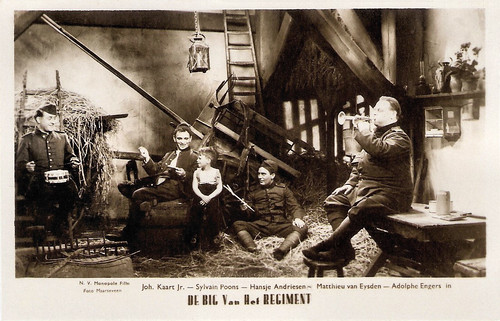
Dutch postcard by Monopole Film NV. Photo: Dick van Maarseveen. Still for De Big van het Regiment/The Darling of the Regiment (Max Nosseck, 1935) with Johan Kaart, Sylvain Poons, Hansje Andriesen, Matthieu van Eysden, and Adolphe Engers. Collection: Geoffrey Donaldson Institute.
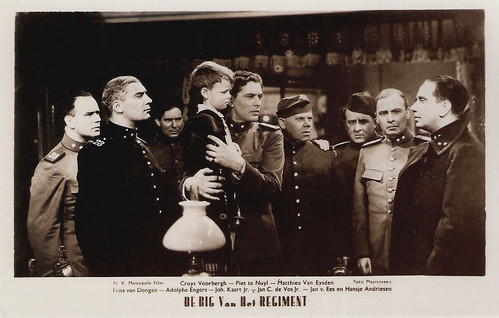
Dutch postcard by Monopole Film NV. Photo: Dick van Maarseveen. Still for De Big van het Regiment/The Darling of the Regiment (Max Nosseck, 1935) with Frits van Dongen, Cruys Voorbergh, Matthieu van Eysden, Adolphe Engers, and Johan Kaart. Collection: Geoffrey Donaldson Institute.
The sound film meant the end of Adolphe Enger's film career in Germany. After a tour through the Dutch Indies, he returned to Holland where he co-wrote and played the lead in the film Terra Nova/New Land (Gerard Rutten, 1932). This fisher drama was meant as the first Dutch sound film, and Engers spoke the first sound-synchronised words in Dutch cinema history (‘The dike is closed’). However, the film disappeared after a dispute between the director and the producer. The first Dutch sound film was considered lost for many decades.
In the following years, Engers acted regularly in front of the camera, while the Dutch film industry blossomed and many German emigrants started to work here. Engers appeared in the musical Op stap/On the Road (Ernst Winar, 1935) with Fien de la Mar, De Big van het Regiment/The Darling of the Regiment (Max Nosseck, 1935) with Frits van Dongen a.k.a. Philip Dorn, and Op een avond in mei/One Evening in May (Jaap Speyer, 1936). Later followed Veertig Jaren/Forty Years (Johan De Meester, Edmond T. Gréville, 1938) and he appeared as a nervous magician in the comic thriller De spooktrein/The Ghost Train (Carl Lamac, 1939), again co-starring with Fien de la Mar.
In the 1930s, he was also active as an author of stage plays and novels like 'Ardjoena - Indische roman' (1936). He gave acting classes at the Conservatory of The Hague. At the start of World War II, he was a member of the stage company De Komedianten (The Comedians), but the Nazis gave the half-Jewish Engers a Berufsverbot. In 1938, Engers was to be honoured for his achievements during 30 years on the stage by an honorary committee that included the author Simon Carmiggelt. Later Carmiggelt related that, when the committee members understood that Engers himself was gay, the officials withdrew from the committee one after the other.
Engers' last films were curiosities he made while hiding from the Nazis. Moord in het modehuis/Murder in the Fashion Store (Alfred Mazure, Piet van der Ham, 1943), was a film version of Mazure’s popular detective comic 'Dick Bos'. The film could not be shown in the cinema. One of the reasons was that Mazure refused to make a Nazi of his hero. After the war, the film was briefly shown in cinemas in 1946. The same team also made another Dick Bos crime film, Ten hoogste negen jaren/At most nine years (Alfred Mazure, Piet van der Ham, 1945).
After the war, he started to appear on stage again in the play 'The Man Who Came to Dinner', but the war had broken him. Several of his family members were killed by the Nazis in their concentration camps. Adolphe Engers suddenly died on 8 December 1945 in The Hague. In 1991 a copy of his lost film Terra Nova (Gerard Rutten, 1932) was found. The former Dutch Filmmuseum (now Eye) reconstructed the film, added a new score to it and reissued the film in 1994.

Dutch postcard by M.B. & Z. (M. Bonnist & Zonen, Amsterdam). Photo: Dick van Maarseveen, Den Haag / Nationaal Film. Publicity still for Op stap/On the Move (Ernst Winar, 1935) with Henriëtte Davids, Adolphe Engers and Jopie Koopman.
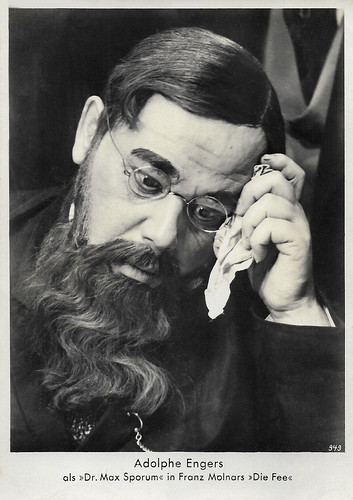
Dutch postcard, no. 949. Photo: publicity still for the stage production of 'A jó tündér/Die Fee/The Good Fairy' by Ferenc Molnar, written in 1930.
Source: Thomas Staedeli (Cyranos), Eye (page now defunct), Joods Monument (Dutch), Wikipedia (German and English) and IMDb.
This post was last updated on 17 February 2024.

German postcard by Ross Verlag, no. 3186/1, 1928-1929.

Dutch postcard, no. 47759. Photo: Hilde Meyer-Kupfer.
Extra for the Comédie-Française
Adolphe 'Dolph' Engers was born in 1884 in Gulpen, in the south of the Netherlands. He was the son of Jewish policeman Wicher Engers en his wife Jetje Wolf. He had three brothers and a sister. Engers attended a trade school in Elberfeld, Germany. There he also took acting classes from Max Martersteig. He returned to the Netherlands and worked for a while for an insurance company.
While he was in Nice for his work, he got in contact with actors of the Comédie-Française and started to work as an extra for the famous French stage company. In Paris, he made also his first film appearances for Gaumont. An actor's strike in France forced him to return to the Netherlands.
In 1912 he was back in Holland and got employment as a stage actor. He also worked as a translator, in particular of 'The Devil' and other works of Hungarian author Ferenc (or Franz) Molnar, but also works by Oscar Wilde, W. Somerset Maugham and Luigi Pirandello.
Engers made his Dutch film debut with De Kroon der schande/The Crown of Shame (Maurits Binger, 1918). Soon followed roles in the British-Dutch production Fate's Plaything/Wat eeuwig blijft (Maurits Binger, B.E. Doxat-Pratt, 1920) and the Dutch production De Bruut/The Brute (Theo Frenkel, 1922).
Engers was married for one week to one of Louis Bouwmeester's daughters before he ended the marriage. He was gay. In 1917, he wrote a stage play on Oscar Wilde, which was never performed, and in 1920 he published 'Peccavi...???', a then-scandalous novel with a gay protagonist, co-written with fellow actor Ernst Winar.

Ernst Winar. German postcard, no. 988/1, 1925-1926. Photo: Kiesel, Berlin. The Dutch actor-director Ernst Winar directed Adolphe Engers in the silent Flappy serial in Berlin, and later again in Holland in Op stap/On the Road (1935).

Dutch postcard by M.B. & Z. (M. Bonnist & Zonen, Amsterdam). Photo: Dick van Maarseveen, Den Haag / Nationaal Film. Publicity still for Op stap/On the Road (Ernst Winar, 1935) with Louis Davids, Rik the dog and Adolphe Engers.
Asta Nielsen
In 1920, Adolphe Engers moved to Germany where he became a very busy film actor. He played in well-known films like Die Benefiz-Vorstellung der vier Teufel/The Benefit performance of the Four Devils (A.W. Sandberg, 1920), Die Geliebte Roswolskys/Roswolsky's Mistress (Felix Basch, 1921) starring the Danish diva Asta Nielsen, and Sie und die Drei/She and the Three (Ewald André Dupont, 1922) starring Henny Porten.
He worked together with Dutch director Jaap Speyer on Der Frauenkönig/The King of the Ladies (Jaap Speyer, 1923), and appeared as Don Esteban Paqueno in Friedrich Wilhelm Murnau’s delicious comedy Die Finanzen des Grossherzogs/Finances of the Grand Duke (1924). He then appeared in Auf Befehl der Pompadour/By Order of That Pompadour Woman (Friedrich Zelnik, 1924) and Elegantes Pack/The Elegant Bunch (Jaap Speyer, 1925) with Eugen Klöpfer, Mary Odette and Ralph Arthur Roberts.
He was also very successful with the Flappy serial, three comedies directed by Ernst Winar for the Berliner Terra Film AG. Winar directed him also in the Dutch-German crime film De man op den Achtergrond/Der Mann im Hintergrund/The Man in the Background (Ernst Winar, 1923). In the second part of the 1920s, the impressive actor went on to appear in such films as Der Prinz und die Tänzerin/The Prince and the Dancer (Richard Eichberg, 1926) with Hans Albers, Die Fahrt ins Abenteuer/The Wooing of Eve (Max Mack, 1926) with Ossi Oswalda and Willy Fritsch.
He appeared again opposite Asta Nielsen in Gehetzte Frauen/Badgered Women (Richard Oswald, 1927). With Liane Haid, he played in Die Königin seines Herzens/The Queen of His Heart (Victor Janson, 1928).
Till the end of the silent era followed Don Juan in der Mädchenschule/Don Juan in the Girls’ School (Reinhold Schünzel, 1928), Sündig und süss/Sinful and Sweet (Carl Lamac, 1929) with Anny Ondra, and Sensation im Wintergarten/Their Son (Joe May, Gennaro Righelli, 1929). Engers also appeared on stage, e.g. at the Deutschen Künstlertheater.

Dutch postcard by Monopole Film NV. Photo: Dick van Maarseveen. Still for De Big van het Regiment/The Darling of the Regiment (Max Nosseck, 1935) with Johan Kaart, Sylvain Poons, Hansje Andriesen, Matthieu van Eysden, and Adolphe Engers. Collection: Geoffrey Donaldson Institute.

Dutch postcard by Monopole Film NV. Photo: Dick van Maarseveen. Still for De Big van het Regiment/The Darling of the Regiment (Max Nosseck, 1935) with Frits van Dongen, Cruys Voorbergh, Matthieu van Eysden, Adolphe Engers, and Johan Kaart. Collection: Geoffrey Donaldson Institute.
Berufsverbot
The sound film meant the end of Adolphe Enger's film career in Germany. After a tour through the Dutch Indies, he returned to Holland where he co-wrote and played the lead in the film Terra Nova/New Land (Gerard Rutten, 1932). This fisher drama was meant as the first Dutch sound film, and Engers spoke the first sound-synchronised words in Dutch cinema history (‘The dike is closed’). However, the film disappeared after a dispute between the director and the producer. The first Dutch sound film was considered lost for many decades.
In the following years, Engers acted regularly in front of the camera, while the Dutch film industry blossomed and many German emigrants started to work here. Engers appeared in the musical Op stap/On the Road (Ernst Winar, 1935) with Fien de la Mar, De Big van het Regiment/The Darling of the Regiment (Max Nosseck, 1935) with Frits van Dongen a.k.a. Philip Dorn, and Op een avond in mei/One Evening in May (Jaap Speyer, 1936). Later followed Veertig Jaren/Forty Years (Johan De Meester, Edmond T. Gréville, 1938) and he appeared as a nervous magician in the comic thriller De spooktrein/The Ghost Train (Carl Lamac, 1939), again co-starring with Fien de la Mar.
In the 1930s, he was also active as an author of stage plays and novels like 'Ardjoena - Indische roman' (1936). He gave acting classes at the Conservatory of The Hague. At the start of World War II, he was a member of the stage company De Komedianten (The Comedians), but the Nazis gave the half-Jewish Engers a Berufsverbot. In 1938, Engers was to be honoured for his achievements during 30 years on the stage by an honorary committee that included the author Simon Carmiggelt. Later Carmiggelt related that, when the committee members understood that Engers himself was gay, the officials withdrew from the committee one after the other.
Engers' last films were curiosities he made while hiding from the Nazis. Moord in het modehuis/Murder in the Fashion Store (Alfred Mazure, Piet van der Ham, 1943), was a film version of Mazure’s popular detective comic 'Dick Bos'. The film could not be shown in the cinema. One of the reasons was that Mazure refused to make a Nazi of his hero. After the war, the film was briefly shown in cinemas in 1946. The same team also made another Dick Bos crime film, Ten hoogste negen jaren/At most nine years (Alfred Mazure, Piet van der Ham, 1945).
After the war, he started to appear on stage again in the play 'The Man Who Came to Dinner', but the war had broken him. Several of his family members were killed by the Nazis in their concentration camps. Adolphe Engers suddenly died on 8 December 1945 in The Hague. In 1991 a copy of his lost film Terra Nova (Gerard Rutten, 1932) was found. The former Dutch Filmmuseum (now Eye) reconstructed the film, added a new score to it and reissued the film in 1994.

Dutch postcard by M.B. & Z. (M. Bonnist & Zonen, Amsterdam). Photo: Dick van Maarseveen, Den Haag / Nationaal Film. Publicity still for Op stap/On the Move (Ernst Winar, 1935) with Henriëtte Davids, Adolphe Engers and Jopie Koopman.

Dutch postcard, no. 949. Photo: publicity still for the stage production of 'A jó tündér/Die Fee/The Good Fairy' by Ferenc Molnar, written in 1930.
Source: Thomas Staedeli (Cyranos), Eye (page now defunct), Joods Monument (Dutch), Wikipedia (German and English) and IMDb.
This post was last updated on 17 February 2024.
1 comment:
After reading this post, Jan sent me a mail. Before Terra Nova (1932),Adolphe Engers worked in 1931 also on Finale, another failed project by director Gerard Rutten. Jan guesses Engers did not appear in Rutten's later project Dood Water, because he did not want to be involved in another debacle. (Dood Water became one of the best films of the Dutch cinema of the 1930's though).
Source: Henk Nijkeuter (Ben van Eysselsteijn (1898-1973), Drent uit heimwee en verlangen).
Post a Comment